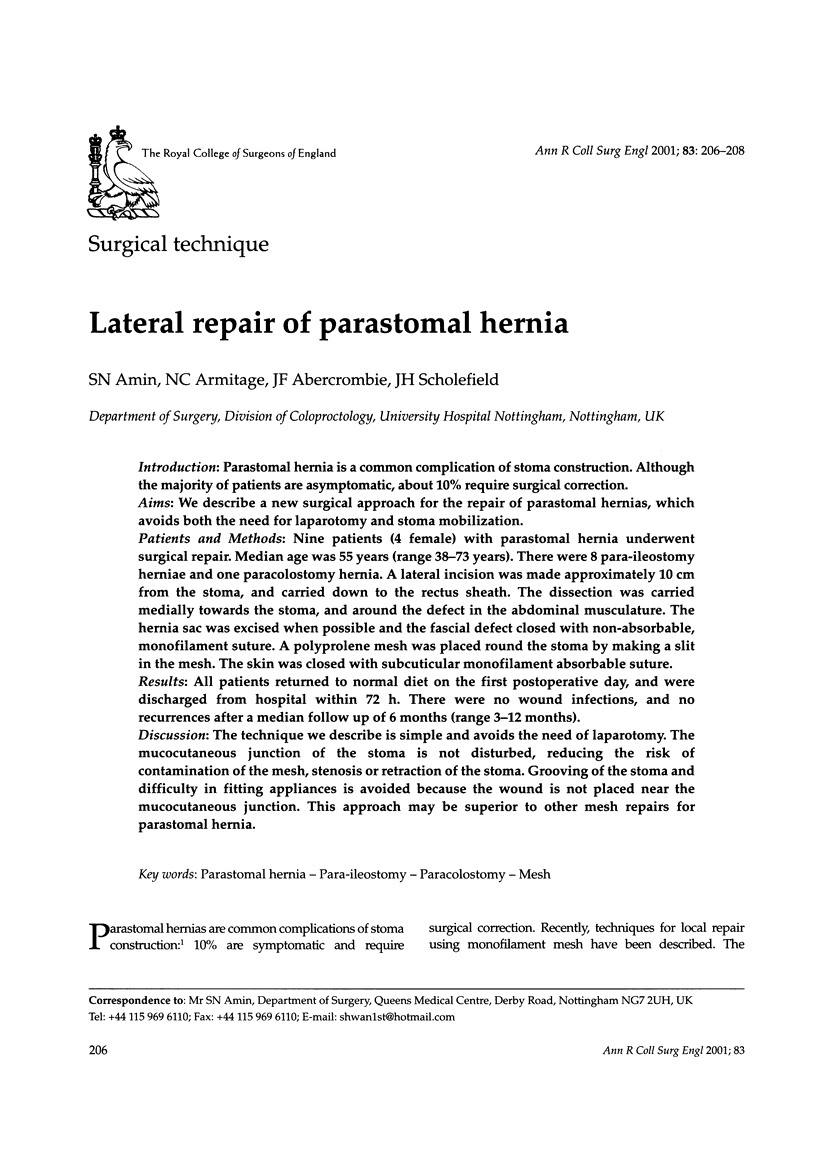Abstract
INTRODUCTION: Parastomal hernia is a common complication of stoma construction. Although the majority of patients are asymptomatic, about 10% require surgical correction. AIMS: We describe a new surgical approach for the repair of parastomal hernias, which avoids both the need for laparotomy and stoma mobilization. PATIENTS AND METHODS: Nine patients (4 female) with parastomal hernia underwent surgical repair. Median age was 55 years (range 38-73 years). There were 8 para-ileostomy herniae and one paracolostomy hernia. A lateral incision was made approximately 10 cm from the stoma, and carried down to the rectus sheath. The dissection was carried medially towards the stoma, and around the defect in the abdominal musculature. The hernia sac was excised when possible and the fascial defect closed with non-absorbable, monofilament suture. A polyprolene mesh was placed round the stoma by making a slit in the mesh. The skin was closed with subcuticular monofilament absorbable suture. RESULTS: All patients returned to normal diet on the first postoperative day, and were discharged from hospital within 72 h. There were no wound infections, and no recurrences after a median follow up of 6 months (range 3-12 months). DISCUSSION: The technique we describe is simple and avoids the need of laparotomy. The mucocutaneous junction of the stoma is not disturbed, reducing the risk of contamination of the mesh, stenosis or retraction of the stoma. Grooving of the stoma and difficulty in fitting appliances is avoided because the wound is not placed near the mucocutaneous junction. This approach may be superior to other mesh repairs for parastomal hernia.
Full text
PDF


Images in this article
Selected References
These references are in PubMed. This may not be the complete list of references from this article.
- Allen-Mersh T. G., Thomson J. P. Surgical treatment of colostomy complications. Br J Surg. 1988 May;75(5):416–418. doi: 10.1002/bjs.1800750507. [DOI] [PubMed] [Google Scholar]
- Byers J. M., Steinberg J. B., Postier R. G. Repair of parastomal hernias using polypropylene mesh. Arch Surg. 1992 Oct;127(10):1246–1247. doi: 10.1001/archsurg.1992.01420100112019. [DOI] [PubMed] [Google Scholar]
- Londono-Schimmer E. E., Leong A. P., Phillips R. K. Life table analysis of stomal complications following colostomy. Dis Colon Rectum. 1994 Sep;37(9):916–920. doi: 10.1007/BF02052598. [DOI] [PubMed] [Google Scholar]
- Morris-Stiff G., Hughes L. E. The continuing challenge of parastomal hernia: failure of a novel polypropylene mesh repair. Ann R Coll Surg Engl. 1998 May;80(3):184–187. [PMC free article] [PubMed] [Google Scholar]
- Rubin M. S., Schoetz D. J., Jr, Matthews J. B. Parastomal hernia. Is stoma relocation superior to fascial repair? Arch Surg. 1994 Apr;129(4):413–419. doi: 10.1001/archsurg.1994.01420280091011. [DOI] [PubMed] [Google Scholar]
- THORLAKSON R. H. TECHNIQUE OF REPAIR OF HERNIATIONS ASSOCIATED WITH COLONIC STOMAS. Surg Gynecol Obstet. 1965 Feb;120:347–350. [PubMed] [Google Scholar]
- de Ruiter P., Bijnen A. B. Successful local repair of paracolostomy hernia with a newly developed prosthetic device. Int J Colorectal Dis. 1992 Sep;7(3):132–134. doi: 10.1007/BF00360352. [DOI] [PubMed] [Google Scholar]




